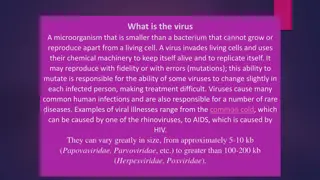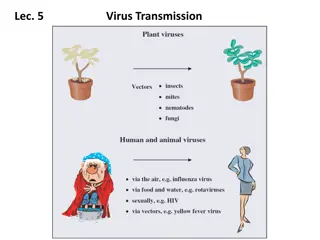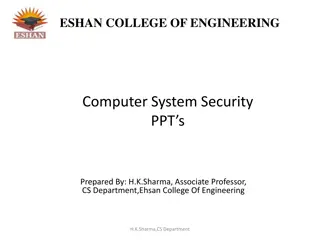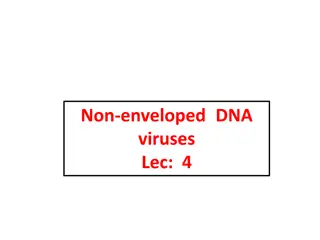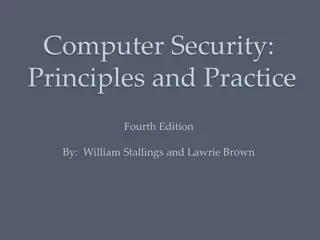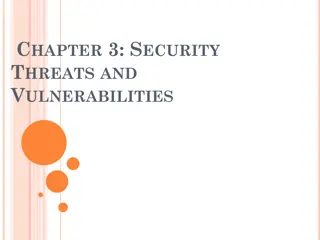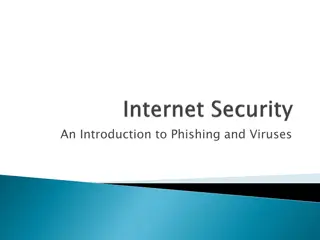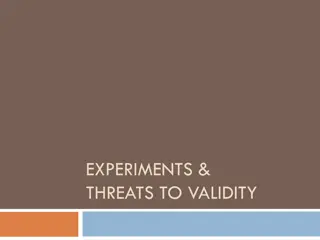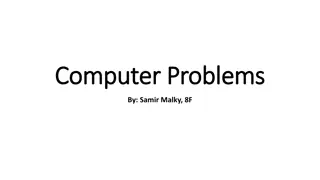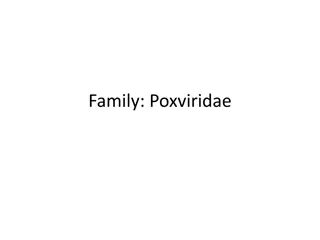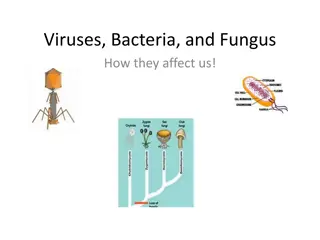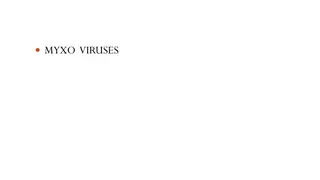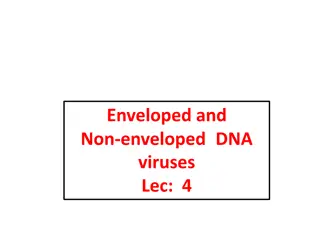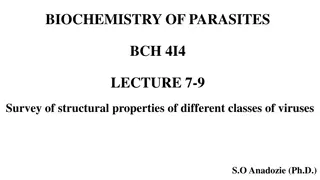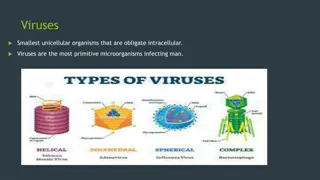Understanding Computer Viruses: Threats and Categories
Learn about computer viruses, their history, classification, and impact. Explore different types like file viruses, polymorphic viruses, and stealth viruses. Understand the categories based on impact and discover macroviruses related to office applications.
Download Presentation

Please find below an Image/Link to download the presentation.
The content on the website is provided AS IS for your information and personal use only. It may not be sold, licensed, or shared on other websites without obtaining consent from the author. Download presentation by click this link. If you encounter any issues during the download, it is possible that the publisher has removed the file from their server.
E N D
Presentation Transcript
BIS Software Threats Roman Danel roman.danel@vsb.cz V B TU Ostrava
Agenda Viruses Trojan Horses Worms Hoax Spyware Phishing Ransomware Exploit Botnet Rootkit
Viruses Virus is a type of malicious software program ("malware") that, when executed, replicates itself by modifying other computer programs and inserting its own code. Infected computer programs can include, as well, data files, or the "boot" sector of the hard drive. When this replication succeeds, the affected areas are then said to be "infected" with a computer virus..
History of viruses 1963 first virus - F. Cohen, Pensylvania uni 1986 first harmful virus 1988 first antivirus - McAfee
Virus Classification File virus Boot, MBR, autorun virus Cluster change in FAT or NTFS tables Network Script Stealth Polymorphic Macrovirus
File virus Overwriting some part of program Parazitic joins to the program without damaging it
Polymorphic virus Changes the code of your body - prevents detection by finding the characteristic virus chain Difficult detection
Stealth virus They mask their activity and hide traces Uses various mechanisms to avoid detection by antivirus software
Virus cathegories by impact Non-destructive - visual or acoustic outputs Annoying - padding letters, rotating screens .... Fighting programs Viruses that destroying data Data-modifying viruses Viruses sending data from your computer Viruses trying to damage hardware Logic Bomb - Starting from a certain date
Macroviruses What is it a macro? Office What is it VBA?
Macroviruses Macro commands for activity automation VBA Visual Basic for Application Effects of location - often do not work in localized versions Spread through e.g. .dot files (Microsoft Word) Function in VBA: AutoExec, AutoOpen, AutoExit
Macroviruses Stealth trying not to be seen in the macros list Polymorfphic Multiparity use VBA, hey work in multiple programs Multiplatform they work on different OS
Ransomware Ransomware is a subset of malware in which the data on a victim's computer is locked, typically by encryption, and payment is demanded before the ransomed data is decrypted and access returned to the victim. The motive for ransomware attacks is nearly always monetary, and unlike other types of attacks, the victim is usually notified that an exploit has occurred and is given instructions for how to recover from the attack.
Viruses Myths Viruses are capable of destroying hardware Viruses can spread in data files Virus can be destroyed only by HD formatting Mail-only viruses can be activated only by running an attachment (there is support for scripts in the body of the message or misinterpretations of the MIME message content that allowed the mass distribution of Win32: Nimda)
Worms Network E-mail
Worms Worms use a mechanism based on a bug in the operating system, database, or web or mail client to spreading. Unlike the virus, they do not need an intermediary. Examples: Happy, PrettyPark, LoveLetter
History of worms The first real worm - 1989 - Big Morris' worm, attacking much of the Internet at that time 2003 - return of classic worms - worldwide epidemic, use of the "DCOM exploit" security hole under Windows 2000 / XP. Common antivirus could not prevent infection, you need to install a Microsoft patch or firewall patch.
Division according Kaspersky Lab File worms they create files for their distribution primarily in system directories, these files with their names are often issued as system files IRC worms Use the IRC (an application layer protocol that facilitates communication in the form of text) property to send data in executable form; a very common way of spreading worms Script worms
Spreading of worms Files sent as e-mail attachments Through a Web link or an FTP resource Via a link sent in an ICQ or IRC message Through peer-to-peer (P2P) networks Some worms are spreading like network packets. The packets penetrate directly into the computer memory where the worm code is activated.
SQLSlammer worm has exploited the security hole in Microsoft SQL Server. If the UDP packets on the 376-byte port 1433 (which is the size of the entire SQLSlammer worm) arrive at MS SQL Server with a non-secured security hole, the underrun buffer has been infected SQLSlammer settled in memory and started generating and then sending more UDP packets to random IP addresses.
Graph showing extreme workload LAN 100 Mbit / s network UDP packets - SQL Slammer worm pou ity podklady Zelenka, J., H k, I.: Ochrana dat. kodliv software, skripta Gaudeamus Hradec Kr lov , 2005
Trojan Horse File:Brad Pitt horse, anakkale.jpg
Trojan Horse Trojan Horse programs that, in addition to doing what they declare, do something else for us - malicious / unwanted. Unlike viruses, they do not spread themselves. Downloaders can also be included in this category. Trojan-proxy - creates a proxy server for additional attacks from the infected computer.
Malware trojan horse Keylogger records keystrokes Dialer Dial-up (often foreign) connection without user's knowledge Dropper After running, it will let the other software be installed in the system and ensure its activating Downloader After starts, allows viruses and Trojans download from a predetermined location Backdoor
Rootkit a program that serves to mask certain attacker's activities and the presence of SW on the computer; attempt to remotely access computers with administrator rights 1986 Brain Virus - Captured attempts to read the boot sector Windows and UNIX systems
Rootkit User-mode rootkit Kernel-mode rootkit Firmware rootkit
Bloatware Bloatware is a term that indicates the tendency for newer computer programs to leave more clues after their installation than necessary, have many unnecessary features that are not used by ordinary users, or offer little or no benefit to their users. Also, software that is preinstalled on a purchased computer and usually is a time-limited trial version or a basic one for a trimmed or "beginner" version.
Exploit A program that uses a known OS or application security vulnerability
Botnet a program that is secretly installed on the user's computer contains a communication and control module and allows an unauthorized user to remotely control and use this computer to perform various commands. Often uses IRC (Internet Relay Chat) chat channels. Estimate - 47 million infected computers Spam, phishing, DoS attacks ...
Password cracker A program designed to remove passwords The method of brute force or dictionary attack
Hoax and Spam Hoax mass-spread false alert, prank or mystification Spam - unsolicited mass-forwarding (most often advertising) communications spread over the Internet
Types of hoax Virus warnings Description of other hazards False requests for help Rumors about mobile phones Petitions and challenges Fraudulent emails (eg from Nigeria) Pyramid games Chain letters of happiness Funeral news
Phishing Fraudulent technique used on the Internet to retrieve sensitive data (passwords, credit card numbers, etc.) from attack victim
Spyware Collects personal information, user activity, or data from the infected computer
Salami Attack Fraud Technique - uses in error or small numerical leftovers to round off Operations in large quantities Hardly detectable
Programme Safety Covert channels Memory Channels - The process that legally writes is captured by the process that records the recorded data Greedy programs for its operations consume a large portion of system performance
Defensive mechanisms against harmful software Antivirus programs, Anti-spyware Single-time virus removal (removers) Regularly installing updates and patches for operating systems (Windows and Linux) System administration rules Strong passwords Application programs do not run under the system account Turn off unused services, close ports, Firewall
How the antivirus works? Scan - search for virus code (strings) Heuristic Analysis - Not dependent on a virus database, looking for suspicious instructions Integrity Test - Check for changes if the virus has not started working Resident protection
Heuristic Analysis Passive Active The issue of "false positives : Too short a string for detection Use incorrect sequences Antivirus sensitivity too high




